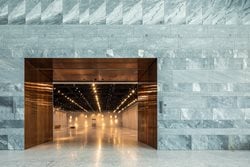
The construction of the Polish History Museum at the Warsaw Citadel is coming to an end. Set to be one of the largest museum facilities in Poland, its architecture is a philosophical tale about the process of history where the language of the narrative about discovering the traces of the past is a stone. The new headquarters of the establishment was designed by the WXCA Architectural Design Studio.
The Museum will open its doors to the public on 28th September.  Stone Monolith as a Metaphor of History The architecture of the Polish History Museum was conceived to be a philosophical tale about the process of history where the language of the narrative about discovering the traces of the past is a stone.
Stone Monolith as a Metaphor of History The architecture of the Polish History Museum was conceived to be a philosophical tale about the process of history where the language of the narrative about discovering the traces of the past is a stone.  “The shape of the minimalist, monolithic Polish History Museum building may be somewhat reminiscent in form of a block of hewn stone. Its façade was finished in different patterned stone slabs that have been arranged in horizontal bands, emphasising the layered, stratigraphic structure of stone. This is the proper structure of geological matter but also of archaeology – natural, social and cultural successive processes. We decided to use marble because of its distinctive pattern. Each of the marble slabs is different, unique, and—just like history—comprises exceptional, individual events” Paweł Grodzicki from the WXCA Architectural Design Studio explained.
“The shape of the minimalist, monolithic Polish History Museum building may be somewhat reminiscent in form of a block of hewn stone. Its façade was finished in different patterned stone slabs that have been arranged in horizontal bands, emphasising the layered, stratigraphic structure of stone. This is the proper structure of geological matter but also of archaeology – natural, social and cultural successive processes. We decided to use marble because of its distinctive pattern. Each of the marble slabs is different, unique, and—just like history—comprises exceptional, individual events” Paweł Grodzicki from the WXCA Architectural Design Studio explained.  All the slabs were arranged in a carefully conceived composition, some in the form of repetitions of subsequent slabs of the block, and others as their mirror image. The architects applied six different methods of working the stone, which allowed specific sections to differ in terms of their tonality and texture. The architectonic detail in the form of ornamentation with quotations from architectural tradition constitutes a symbolic complement to the whole design.
All the slabs were arranged in a carefully conceived composition, some in the form of repetitions of subsequent slabs of the block, and others as their mirror image. The architects applied six different methods of working the stone, which allowed specific sections to differ in terms of their tonality and texture. The architectonic detail in the form of ornamentation with quotations from architectural tradition constitutes a symbolic complement to the whole design.
They can be interpreted as artefacts from different periods in an archaeological cross-section. They are not direct quotes, however, but spatial graphics subject to geometric transformation, making references to such patterns as the relief from the Gniezno Doors, the crystal vault known from the Gothic period (e.g., the Basilica of the Assumption of the Blessed Virgin Mary in Gdansk), the decorations of St Sigismund’s Chapel in Krakow, or the motive from the modernist Spodek arena complex in Katowice.
***
Press release and photos courtesy of WXCA Architectural Design Studio
Photos ©Daniel Ciesielski




 25
25
comment